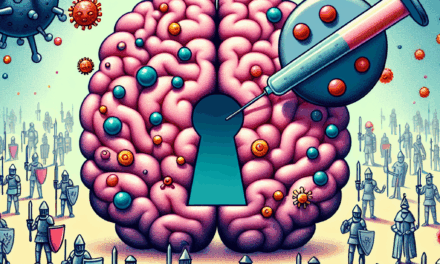Understanding the Gender Gap in Teenage Depression: Insights into Girls’ Mental Health
The mental health landscape for teenagers is complex and multifaceted, with significant disparities between genders. Recent studies indicate that teenage girls are experiencing higher rates of depression compared to their male counterparts. This article delves into the various factors contributing to this gender gap in teenage depression, providing insights into the unique challenges faced by girls. We will explore the biological, social, and cultural influences that shape girls’ mental health, the impact of social media, the role of family dynamics, and the importance of early intervention and support systems.
1. Biological Factors Influencing Depression in Teenage Girls
Understanding the biological underpinnings of depression is crucial in addressing the gender gap in mental health. Research suggests that hormonal changes during puberty can significantly impact mood and emotional regulation in girls.
- Hormonal Changes: The onset of menstruation introduces fluctuations in estrogen and progesterone levels, which can affect neurotransmitter systems involved in mood regulation. Studies have shown that these hormonal changes can lead to increased vulnerability to depression.
- Genetic Predisposition: Genetic factors also play a role in the development of depression. Girls may inherit a predisposition to mood disorders, which can be exacerbated by environmental stressors.
- Brain Development: The adolescent brain undergoes significant changes, particularly in areas responsible for emotional regulation and decision-making. Research indicates that girls may experience these changes differently than boys, potentially leading to heightened emotional sensitivity.
For instance, a study published in the journal “Psychological Medicine” found that girls are more likely to experience depressive symptoms during puberty than boys, suggesting a biological basis for the gender disparity. Furthermore, the interaction between genetic predisposition and environmental factors, such as stress and trauma, can create a perfect storm for the onset of depression in teenage girls.
Additionally, the prevalence of anxiety disorders among girls can also contribute to depressive symptoms. Anxiety and depression often co-occur, and girls are statistically more likely to experience anxiety disorders during adolescence. This co-morbidity can complicate treatment and recovery, making it essential to address both conditions simultaneously.
2. Social and Cultural Influences on Girls’ Mental Health
Social and cultural factors play a significant role in shaping the mental health of teenage girls. The pressures of societal expectations, peer relationships, and cultural norms can contribute to feelings of inadequacy and depression.
- Societal Expectations: Girls often face immense pressure to conform to societal standards of beauty, success, and behavior. These expectations can lead to low self-esteem and body image issues, which are closely linked to depression.
- Peer Relationships: The teenage years are marked by the formation of peer relationships, which can be both a source of support and stress. Girls may experience relational aggression, bullying, and social exclusion, all of which can contribute to depressive symptoms.
- Cultural Norms: Cultural attitudes towards mental health can influence how girls perceive and respond to their emotional struggles. In some cultures, mental health issues may be stigmatized, leading to a reluctance to seek help.
For example, a survey conducted by the American Psychological Association found that girls are more likely than boys to report feeling pressure to be perfect, which can lead to anxiety and depression. The impact of social media cannot be overlooked in this context, as platforms often amplify unrealistic standards and foster comparison, further exacerbating feelings of inadequacy.
Moreover, cultural narratives surrounding femininity can also play a role in shaping girls’ mental health. In many cultures, girls are socialized to prioritize relationships and caregiving, which can lead to neglecting their own needs and emotional well-being. This self-sacrificing behavior can contribute to feelings of burnout and depression.
3. The Impact of Social Media on Teenage Girls’ Mental Health
In the digital age, social media has become a pervasive influence in the lives of teenagers. While it can offer opportunities for connection and self-expression, it also poses significant risks to mental health, particularly for girls.
- Comparison Culture: Social media platforms often promote a culture of comparison, where users measure their worth against curated images and lifestyles. This can lead to feelings of inadequacy and low self-esteem among teenage girls.
- Cyberbullying: The anonymity of social media can facilitate bullying and harassment, which can have devastating effects on mental health. Girls are often the targets of cyberbullying, leading to increased rates of depression and anxiety.
- Fear of Missing Out (FOMO): Social media can exacerbate feelings of isolation and loneliness, as girls may feel excluded from social events and experiences shared online. This phenomenon, known as FOMO, can contribute to depressive symptoms.
A study published in the journal “JAMA Psychiatry” found that increased social media use is associated with higher rates of depression among teenage girls. The study highlighted that girls who spend more time on social media are more likely to report feelings of sadness and hopelessness.
Furthermore, the pressure to maintain a certain online persona can lead to anxiety and stress. Girls may feel compelled to present an idealized version of themselves, which can be exhausting and detrimental to their mental health. The constant need for validation through likes and comments can create a cycle of dependency on external approval, further impacting self-esteem.
4. Family Dynamics and Their Role in Girls’ Mental Health
The family environment plays a crucial role in shaping the mental health of teenage girls. Supportive family dynamics can foster resilience, while negative or dysfunctional relationships can contribute to depression.
- Parental Relationships: The quality of relationships with parents can significantly impact a girl’s mental health. Supportive and nurturing parenting can promote emotional well-being, while conflictual or neglectful relationships can lead to feelings of worthlessness and depression.
- Communication Styles: Open and honest communication within families can help girls express their feelings and seek help when needed. Conversely, families that discourage emotional expression may inadvertently contribute to mental health issues.
- Socioeconomic Factors: Economic stressors can also affect family dynamics and, consequently, girls’ mental health. Families facing financial difficulties may experience increased conflict and stress, which can impact the emotional well-being of teenage girls.
For instance, a study published in “Child Development” found that girls from supportive family backgrounds were less likely to experience depression compared to those from high-conflict families. The study emphasized the importance of parental involvement and emotional support in mitigating the risk of depression.
Additionally, family history of mental health issues can also play a role in a girl’s vulnerability to depression. If a family member has experienced depression, girls may be more likely to develop similar issues, highlighting the need for awareness and proactive support within families.
5. The Importance of Early Intervention and Support Systems
Addressing the gender gap in teenage depression requires a multifaceted approach that includes early intervention and robust support systems. Recognizing the signs of depression and providing timely support can make a significant difference in the lives of affected girls.
- Awareness and Education: Increasing awareness about the signs and symptoms of depression is crucial for early intervention. Schools, parents, and communities should be educated on how to recognize mental health issues in teenage girls.
- Access to Mental Health Resources: Ensuring that girls have access to mental health resources, including counseling and therapy, is essential. Schools should provide mental health services and create a safe environment for girls to seek help.
- Peer Support Programs: Implementing peer support programs can foster a sense of community and belonging among girls. These programs can provide a platform for sharing experiences and coping strategies, reducing feelings of isolation.
A study published in “The Lancet Psychiatry” found that early intervention programs significantly reduce the risk of developing severe depression in adolescents. The study highlighted the importance of providing support before symptoms escalate, emphasizing the need for proactive measures.
Moreover, involving parents in the intervention process can enhance the effectiveness of support systems. Family therapy and parent education programs can equip families with the tools needed to support their daughters’ mental health effectively.
Conclusion
The gender gap in teenage depression is a pressing issue that requires attention from parents, educators, and mental health professionals. By understanding the biological, social, and cultural factors that contribute to this disparity, we can develop targeted interventions to support girls’ mental health. The impact of social media, family dynamics, and the importance of early intervention cannot be overstated. As we work towards creating a more supportive environment for teenage girls, we must prioritize mental health awareness and access to resources. By doing so, we can help bridge the gender gap in teenage depression and foster resilience in the next generation.





